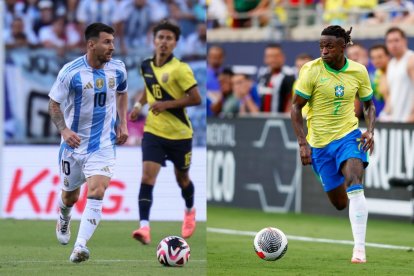Copa América 2024: aspirations of Argentina and Brazil, threatened by Uruguay, Mexico, Colombia and the USMNT
The United States hosts the 48th edition of the most important soccer tournament in the Americas at the national team level. It will be held between June 20 and July 14.

(
Argentina, Canada, Chile, Peru, Ecuador, Jamaica, Mexico, Venezuela, United States (USMNT), Bolivia, Panama, Uruguay, Brazil, Colombia, Costa Rica and Paraguay are already prepared for their great challenge this season. This Thursday, the Copa América 2024 starts, the most important football tournament in the Americas at the national team level.
The 48th edition, which will be co-organized by the South American Football Confederation (CONMEBOL) and the Confederation of North, Central America and Caribbean Football (CONCACAF), will be held in the United States between June 20 and July 14. It will once again have 16 participants, being the second time that it has this number of teams. The first was the 45th edition, which was also held in the United States.
In total, 14 stadiums will host the 32 games that will be played throughout the entire tournament, from the group stage to the final: Mercedes-Benz Stadium (Atlanta, Georgia), MetLife Stadium (East Rutherford, New Jersey), Inter&Co Stadium (Orlando, Florida), Bank of America Stadium (Charlotte, North Carolina), GEHA Field at Arrowhead Stadium (Kansas City, Missouri), Children's Mercy Park (Kansas City, Missouri), AT&T Stadium (Arlington, Texas), NRG Stadium (Houston, Texas), Q2 Stadium (Austin, Texas), State Farm Stadium (Glendale, Arizona), Allegiant Stadium (Las Vegas, Nevada), SoFi Stadium (Inglewood, California), Levi's Stadium (Santa Clara, California) and Hard Rock Stadium (Miami, Florida). The latter will be the venue for the final, despite not being the venue with the greatest capacity.
The Argentine and Canadian teams will play the opening game at the Mercedes-Benz Stadium in Atlanta.

Mercedes-Benz Stadium (Atlanta, Georgia).
Mercedes-Benz Stadium (AFP)
From the group stage to the final
Before the national teams access the next round of the Copa América, they must each play three games in a group stage that was configured as follows:
The two best finishers in each group will advance to the quarterfinals, scheduled for July 4, 5 and 6. The semifinals will be played on July 9 and 10, while the game for third and fourth place will be on July 13 and the final will be on July 14.
The favorites, as always
"Argentina is always a favorite, just like Brazil. Uruguay, Colombia and Ecuador are doing very well. It's going to be a very close Copa América." These words belong to who is considered by many to be the best footballer of all time: Leo Messi. The Argentinian star, who will turn 37 while playing in the top tournament in the Americas, assessed each of the national teams' positions coming into this event.
For Messi - this being his last Copa América with absolute certainty -, his team and Brazil are the great contenders. Of course, the Inter Miami player did not mention any non-South American team. Soccer experts have a similar opinion to Messi's, positioning the Albiceleste and the Canarinha - champions 15 and 9 times, respectively - as the clear favorites to win the title. Without a doubt, they have better players than their rivals. The technical directors Lionel Scaloni (Argentina) and Dorival Júnior (Brazil) called on footballers of Messi's stature, Ángel Di María, Lautaro Martínez, Vinícius Júnior, Rodrygo Goes and Éder Militao.
After Argentina and Brazil, experts place Uruguay as third with the highest likelihood. The national team led by veteran Argentinian coach Marcelo Bielsa goes to the United States with the aim of adding its sixteenth title to its record and becoming the team with the greatest number of wins, thus standing out in the ranking of Argentine champions. Fede Valverde, Luis Suárez and Ronald Araujo will lead the blue team.
This is how the USMNT is coming into 'its' Copa América
With less likelihood, national teams such as Mexico and Colombia are placed, followed by the USMNT. The national team of stars and stripes, which does not know what it is like to stand on the podium of the Copa América, obtained its best result (fourth place) in the 1995 and 2016 editions when it hosted the tournament for the first time.
Gregg Berhalter, who has led the USMNT since 2023, has called on several young football players who, for the most part, wear the jerseys of important teams in Europe, such as Christian Pulisic (AC Milan) or Timothy Weah (Juventus), son of the legendary George Weah, winner of the Ballon d'Or in 1995.
Before starting the Copa América, the USMNT has played two preparatory games against two major rivals: Colombia and Brazil. They left a bad impression against the coffee growers at Commanders Field in Landover (Maryland) when they fell behind with a whopping 5-1. Against the canarinha, a match played at the Camping World Stadium in Orlando (Florida), they improved and won 1-1. They will meet Bolivia in the first match of the tournament.
The USMNT has a factor that could be decisive in reaching high levels in the Copa América. They play at home in front of their fans. So the support of the fans will be essential for the national team to, perhaps, add the first title to its showcase.
Copa América's honors
Up to eight national teams are included in the list of winners of the Copa América:
Recommendation





















